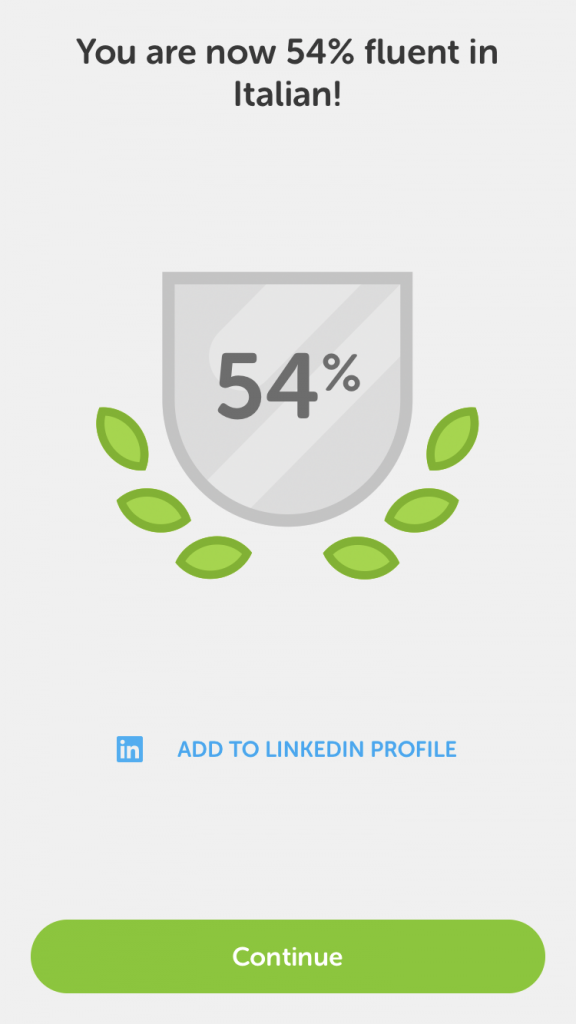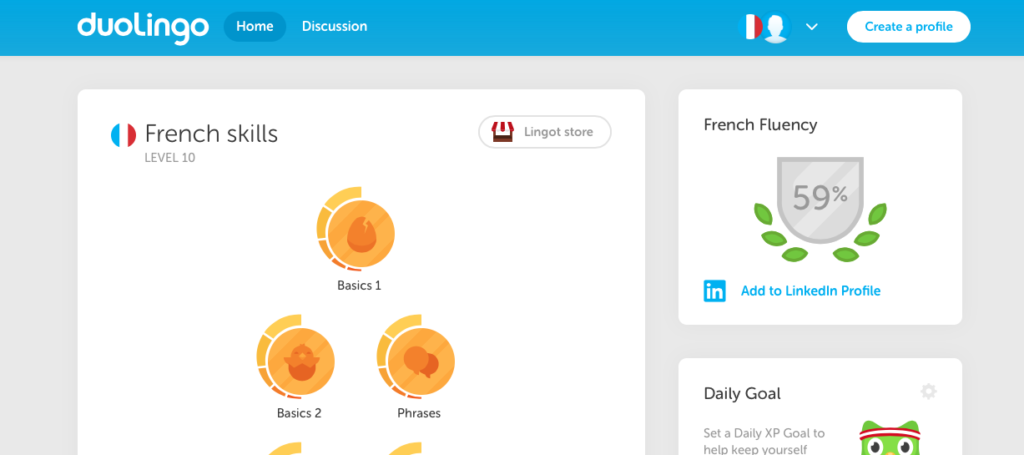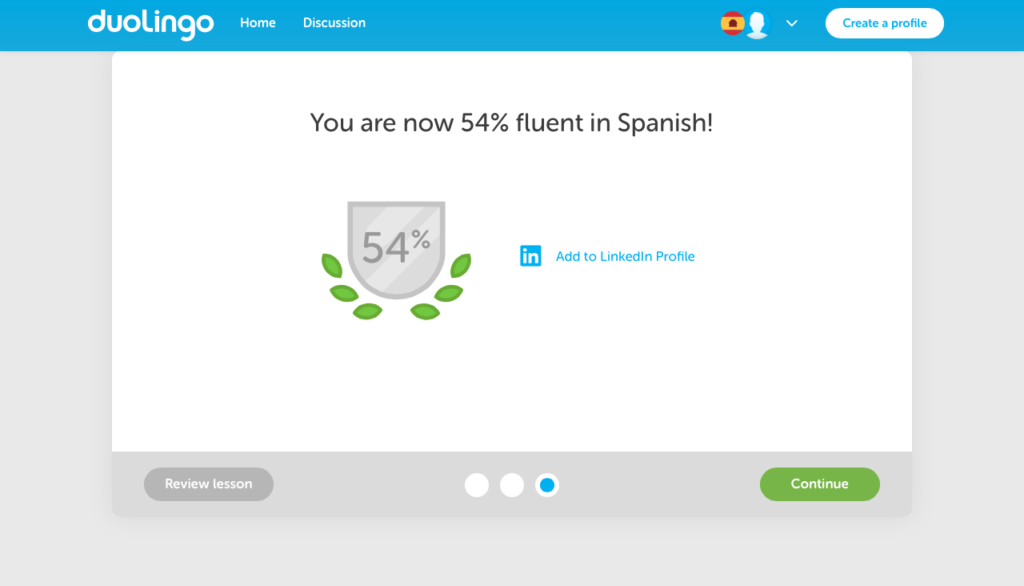Duolingo is EVERYWHERE. The founder, Luis Von Ahn, is a genius. He took his passion and curiosity to combine the power of the human brain and computer science to make a completely free language learning program for people all over the world. While I think that focusing on an application to learn a language should not and can not replace the real input and practice one gets from talking to actual human beings who speak the target language, spending some time in Duolingo can certainly transform downtime into new language skills. The cumulation of time spent in language is critical to achieving fluency in any language. Duolingo can help with that.
How it Works
After taking a placement test, you are given a percentage score for fluency. When you start Duolingo, you are given the choice of different topics. You earn experience points as you move through these topics, which reside on “trees”. Once you have worked through the all of the trees (they will all be golden), they begin to fade. You must return to strengthen these trees to return them to gold. Once you have a certain number of experience points, you will be considered 100% fluent.
Von Ahn has managed to tap into the type of addiction and passion many have with video games. Users translate sentences and earn points for correct answers. A certain number of correct answers moves users up in their fluency measurement percentages and earns them experience points. Groups of people can even compete, adding to the game-like feel of the program. In addition to teaching vocabulary and grammar through translation, imagine brains with dopamine rushing through them each time a sound goes off, letting the user know that another answer is correct or another level is achieved. How rewarding is that- tangible and visible progress staring right at you.
Duolingo and Assessing Language Skills
As a lifelong language learner and teacher, I had to give Duolingo a try. I have a lot of young people in my life, and many told me how much they enjoy Duolingo. Anything that produces results while engaging people is definitely worth a try, in my opinion. I took the placement test on my iphone and started trying out the resources for French.
Duolingo rewards experience points for correct translations. It also offers users the opportunity to do something until they have achieved mastery, so there is always room to move forward. I personally found quite a few sentences presented to me odd. I can’t remember verbatim many of the sentences, but ones like The people have fish followed by Six dogs have a bath seem to be in my head. Considering this, I did not find the content for beginners particularly helpful for early communication. I am a strong advocate for survival language to begin, and put a strong emphasis on words and phrases that can get you communicating with native speakers early and often. This gets people confident with speaking right away. The ultimate goal of language learning is communication, right? Think learning to meet and greet, get food and drink and get to where you are sleeping for the night. Once you can feel confident with some very basic language tasks, skills can grow rapidly from there. Having said that, I love anything that turns idle time into language learning time. Duolingo can teach vocabulary and many linguistic patterns. You need words to communicate, and you need to know how to put them together to make sense, so patterns are important.
After seeing how it worked and experimenting with the translations myself, I felt quite bored. This was not completely unexpected, as I am a B2 level speaker of French (a link if you are unfamiliar with these levels). Essentially, I am a confident communicator in French in many situations and at a level that most would consider fluent, but I do not have the ease of expression I have in my C2 level Spanish. The basic translations of sentences- the vast majority of which I was getting correct with the exception of a missing accent here and there-did not make me feel as though I was really building my skills. I was just translating sentences.
To see how I could be what many consider fluent in French, yet only see my fluency score around 55%, I did a little experiment. I took the placement test in French, and this was my score:
I then did another test on a clear browser. This time, I had two of my French stepchildren (they live and study about an hour outside of Paris) do the test with me. Our score was no better.
I then decided to test my Spanish. I am a C2 level speaker of Spanish. I have done official testing as well in the US to demonstrate native-like fluency on the ACTFL scale. I am also a certified proficiency rater for learners of Spanish. Here is my score:
I must also point out that all of the tests were done meticulously, and with no errors.
When I started my 200-hour Challenge in Italian, I was at an A2-level. I would equate this to the upper-end of the ACTFL Novice range in which a learner moves from the memorized words and phrases level and can start creating with language and having more sustained conversations. After completing 100 hours of study, I tool the Duolingo placement test. Here are my results:

Proficiency is what functional, practical things a person can do in a language. They are the actual communicative skills that a person has. I can speak in long paragraphs in French, and speak for extended periods of time in Spanish. Duolingo works with an algorithm that tests the time you spend translating sentences between languages in their program. As such, it has no idea what a person can or can’t do in a language in communicative situations. In seeing the results of the Duolingo tests that I took, I see that Duolingo (at this point in their development) can help people who are working in the novice level (learning words into beginning to be able to make their own sentences), and can’t offer much valuable assessment advice beyond that beginning level (yet).
If you are starting to learn a language, Duolingo is a fantastic way to complement a program and turn otherwise unoccupied time into language learning time. If you want to really move further, you will need to learn about assessment methods beyond Duolingo’s percentages. Several tools are available here in the Self-assessment workbook.

